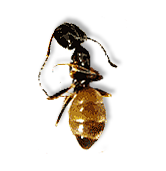General Characteristics:
- Workers are 1/16-1/8 inches long
- Brownish black in colour
- Often confused with the Argentine ant, but it is darker in colour and the abdomen extends over the petiole
- When crushed, gives off a distinct rotten coconut smell
- Will eat almost anything, including insects, seeds, honey, honeydew, bread, meats, nuts and cheese
Reproduction:
- Nests both indoors and outdoors in, with outdoor nests being generally shallow and under stones or pavement cracks, and indoor nests located in walls or under floors
- Colonies can be quite large in numbers and have multiple actively breeding queens
Signs of Infestation:
- During seasons when honeydew is scarce these ant may enter structures
- Although not damaging to humans or structures, they can contaminate food
- Workers lay down pheromone trails that others follow, so ants may be seen following similar patterns of movement
- Within structures many ants may be observed foraging for food
Control Techniques:
- Sealing structural holes is vital for interior control of this ant species. PLEASE REMEMBER NOT TO SEAL ANY STRUCTURAL BREATHING HOLES AS THESE ARE NECESSARY FOR THE MOVEMENT OF MOISTURE THROUGH VOID AREAS IN A STRUCTURE.
- Sanitation of organic debris will reduce interior food supply and make structure less conducive to ant usage
- We recommend professional consultation if problems persist to determine the most appropriate solution
Please click here to contact a Focus Pest Control professional to inquire about further treatments for this pest species.
References:
Benett, Gary W., et.al.. Truman’s Scientific Guide to Pest Control Operations. Duluth: Advanstar Communications, 1988.
Pp. 354-357.
"Welcome to the Pest World" (On-line). National Pest Management Association Inc. Accessed May 15, 2009 at http://www.pestworld.com/for-consumers/Pest-Guide/Pest/ Odorous-House-Ants >.
Disclaimer:
The Focus Pest Control ‘Pest Library’ is an educational resource written largely to educate the general public about common pests in Ontario. The Focus ‘Pest Library’ does not include all species in Ontario, nor does it include the most recent scientific data about species we describe. Though we edit our accounts for accuracy, we cannot guarantee all information in those accounts. While Focus Pest Control staff and contributors provide references to books and websites that we believe are reputable, we cannot necessarily endorse the contents of references beyond our control.
(Back to top)
|


